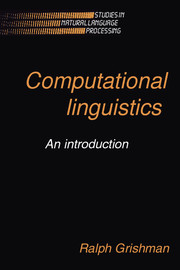4 - Discourse analysis and information structuring
Published online by Cambridge University Press: 05 June 2012
Summary
Up to now, we have restricted ourselves to determining the structure and meaning of individual sentences. Although we have used limited extrasentential information (for anaphora resolution), we have not examined the structure of entire texts. Yet the information conveyed by a text is clearly more than the sum of its parts – more than the meanings of its individual sentences. If a text tells a story, describes a procedure, or offers an argument, we must understand the connections between the component sentences in order to have fully understood the story. These connections are needed both per se (to answer questions about why an event occurred, for example) and to resolve ambiguities in the meanings of individual sentences. Discourse analysis is the study of these connections. Because these connections are usually implicit in the text, identifying them may be a difficult task.
As a simple example of the problems we face, consider the following brief description of a naval encounter:
Just before dawn, the Valiant sighted the Zwiebel and fired two torpedoes. It sank swiftly, leaving few survivors.
The most evident linguistic problem we face is finding an antecedent for ‘it’. There are four candidates in the first sentence: ‘dawn’, ‘Valiant’, ‘Zwiebel’, and ‘torpedoes’. Semantic classification should enable us to exclude ‘dawn’ (*‘dawn sinks’), and number agreement will exclude ‘torpedoes’, but that still leaves us with two candidates: ‘the Valiant’ and ‘the Zwiebel’ (which are presumably both ships of some sort).
- Type
- Chapter
- Information
- Computational LinguisticsAn Introduction, pp. 140 - 158Publisher: Cambridge University PressPrint publication year: 1986



